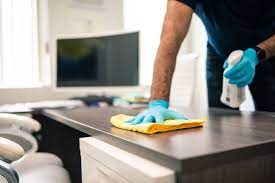Fighting a battle with invisible enemies such as microbes, germs, and viruses is more difficult than in the national borders. For that, we need to sanitize everything, including our homes. You can do it yourself or find a company that sanitizes houses. Home sanitization is a complicated task where you have to look after the various aspects of your home. At the same time, you must be well informed about the cleaning and sanitization process. You have to keep in mind that:
- Sanitization and cleaning are two different processes.
- Cleaning follows sanitization, i.e., without cleaning, sanitization is not possible.
- The normal cleaning we do every day is not enough.
- There is no scope for complacency, and you have to ensure that the house is sanitized.
How to Disinfect Whole House – Important Arrangement and a Few Things to Remember
Sanitization and cleaning in moments of extreme emergency help in the prevention of contagious illnesses to a large degree. So for the safety of your family members, you have to be knowledgeable about the best ways to eliminate germs in the house.
A few arrangements before starting the home sanitization process-
- You’ll require a pair of disposable gloves. Alternatively, you can also use rubber gloves, but remember to sanitize them after using them.
- A bottle of DIY home disinfectant. Different brands are available in the market; alternatively, you can make one at home also using bleaching powder.
- Other cleaning tools and equipment, such as sponges, clothes, vacuum cleaner, brush, and broom.
A few things to remember while disinfecting and sanitizing the house –
- It is important to identify high-touch surfaces such as countertops, tables, light switches, chairs, doorknobs, chair headrests, television remotes, computer keywords, mobile phones, sinks, faucets, etc.
- Avoid touching any switch or running electric appliances while working.
- Make sure to keep children and elderly family members away while cleaning a room
- If you’re disinfecting and sanitizing the house by yourself, you should know how to sanitize house.
Which Areas Need to Be Sanitized in Your Residential Space?
In general, all areas are not infected to the same extent. Some areas are extremely contaminated, and others aren’t. The degree of contamination is determined with the help of Swab Test done along with home sanitizing services. According to the level of infection and risk factors, the areas are divided into four zones. High risk area is Red zone, medium risk area is Orange zone, low risk area is Yellow zone and no risk area is Green zone.
We shouldn’t consider our home area as the only area of concern. The entire residential area must be considered and treated.
However, here are some ways about how to sanitize home by self.
How to Sanitize Your Home – A Complete Checklist for Effective Sanitization
STEP 1: HOW TO DISINFECT A ROOM?
- Clean the floor with a broom
- Use your vacuum to sweep the areas the broom can’t reach.
- Vacuum your sofa, carpet, cushions, bed, and any other furniture
- Dust the windows and doors with a clean, dry cloth
- Dust the electronic items with a brush and a piece of cloth as suitable
After completing the primary cleaning and dusting, do the following:
- Add disinfectant in a bucket of water and deep-clean the open floor area
- Use a mild mixture of soap-water and a sponge to clean all the material surfaces, especially the high-touching points
- Use a disinfectant to clean all these places once again with a sponge or small piece of cotton cloth
- Let this dry naturally
Clean the electrical and electronic products in the following way:
- Follow the specific instructions for the cleaning of electrical and electronic products.
- Use an alcohol-based disinfectant to sanitize mobile phones, land phones, TV, and other electronic goods
It is always feasible to use suitable covers for electronic items like mobile phones to minimize the burden of sanitization.
STEP 2: HOW TO SANITIZE A BATHROOM?
- Use a soap-water solution to clean all surfaces, including sink, faucets, tub, all handles, doorknob, flush, and windowpanes
- Use a high-quality toilet cleaner to scrub the toilet completely
- Let the surfaces air dry naturally, or use an air blower
- Pour a homemade disinfectant (with bleaching powder and water) and spray it everywhere in the bathroom
- Let the surfaces dry naturally that kills most of the invisible germs
- Make use of the same method to clean the floor of the bathroom
STEP 3: HOW TO SANITIZE A KITCHEN?
Kitchen sanitization follows the same process as a bathroom or room, and you need to pay special attention to certain areas of it:
- Deep clean and sanitize the sink
- Clean the outlay pipe of the sink if accessible
- Clean the counters and stovetop with soap and water using a sponge, or a dry, clean cloth
- Use soap and hot water to wash the touching boards
- Vacate the refrigerator and clean it with a mild mixture of dishwashing liquid and water, followed by cleaning with normal water.
- Clean the mixture grinder in the same way, followed by cleaning with normal water
How to Disinfect Your House with the Help of House Sanitizing Services?
Expert cleaning and sanitizing services provide complete protection against various highly infectious microbes. You need to ask to help with a house sanitizing service that promises to provide you:
- A transparent antimicrobial coating on the surface of the home
- Gives 99.99% germ-kill protection
- Complete sanitization of home to ensure it is virus-free
- Successful against SARS and other droplet-based viruses
- Effective for 3 months
In addition to this, there will be no smell, no color, and no side effects.
FREQUENTLY ASKED QUESTIONS
Q: Why is it important to sanitize my home?
A: Sanitizing your home can help to reduce the spread of bacteria and germs, which can cause illness. It is especially crucial during times of outbreaks or pandemics like COVID-19 to prevent the spread of the virus.
Q: What areas of my home should I focus on when sanitizing?
A: It is important to focus on high-touch surfaces and areas where bacteria and germs are likely to spread. These include doorknobs, light switches, countertops, faucet handles, toilet handles, and any other frequently touched surfaces.
Q: What products should I use to sanitize my home?
A: The Centers for Disease Control and Prevention (CDC) suggest using an EPA-approved disinfectant or a solution that contains atleast 70% alcohol to sanitize surfaces effectively. You can also use a mixture of bleach and water (4 teaspoons of bleach per quart of water) as a disinfectant, but be sure to follow proper safety precautions when using bleach.
Q: How often should I sanitize my home?
A: The frequency of sanitizing your home will depend on your level of risk and exposure. If you’ve been in contact with someone who is sick or if there is an outbreak in your community, it is recommended to increase the frequency of sanitizing. Otherwise, sanitizing once a day or every few days may be enough.
Q: Are there any natural alternatives to chemical disinfectants?
A: Absolutely, there are many natural alternatives that can be effective in sanitizing your home, such as hydrogen peroxide, vinegar as well as essential oils. However, it’s important to keep in mind that these natural alternatives may not be as effective as chemical disinfectants, and it is important to follow proper safety precautions when using them.




